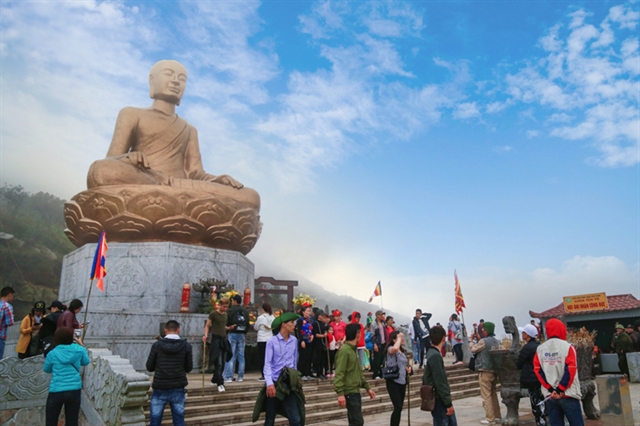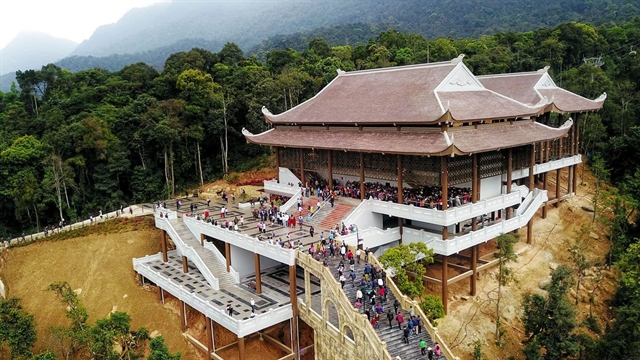 Features
Features

Trần Nhân Tông, the King and the Buddha of the Vietnamese

|
| Peaceful figure: Buddhist King Trần Nhân Tông ceded the Emperor's crown to reside on a secluded mountaintop to live the simple agrarian life of a monk. Photo courtesy of VOV |
by Trí Bửu
The UN Day of Vesak Celebrations has become an opportunity to rejoice Buddha's birth in Việt Nam, where Buddhist followers number in the millions.
In his opening remarks at the 2008 UN International Vesak Day in Hà Nội, then President Nguyễn Minh Triết noted: “Việt Nam is a multi-religion country in which Buddhism arrived quite early in history, some 2,000 years ago. Since its very first days in this country, Buddhism with its philosophy on the four immeasurables of loving -kindness, compassion, empathetic joy and equanimity - has been well received and has accompanied this nation in the spirit of joining the earthly life, combining the religion and the material life for man's happiness and peace.
“Throughout history, Vietnamese people and the nation have seen the emergence of great Buddhist dignitaries offering their talents and virtues to help protect the country and pacify the people. It is in this special context that Vietnamese history records the birth and reign of the wise King Trần Nhân Tông who performed great deeds in the defence of the motherland. Once the country returned to peace, he gave up all his worldly treasures and wealth to find a place on Yên Tử Mountain to practise his religion and found the Trúc Lâm Zen School with its typical Vietnamese characteristics that exists until the present day.”
The Đại Việt Sử Ký Toàn thư (Complete Annals of the Đại Việt) writes “King Trần Nhân Tông was born as Trần Khâm and as the first son of King Thánh Tông. His mother was Queen Nguyên Thánh Thiên Cảm. He was born on December 7, 1258 in the Year of the Horse. He got the essence of the nobles and had a stately look, golden appearance, great physique and bright spirit. Both the palaces considered this a strange sign and thus, called him Kim Tiên Đồng Tử (Saintly Boy). On his left shoulder there was a black mole, suggesting he was ready to carry out great missions. He was on the throne for 14 years and then ceded it for 5 years. He joined the monkhood for 8 years and died at the age of 51 at Ngọa Vân hermitage on Yên Tử Mountain and was entombed at Đức Lăng. The King was compassionate and gentle, able to unite the people and successful in his cause of furthering his predecessors' steps and deserved to be a virtuous king of the Trần Dynasty.”

|
| Holy spot: Trúc Lâm Yên Tử, a sacred destination for Buddhist followers all year round. VNA/VNS Photo Thành Đạt |
King Trần Nhân Tông was born and grew up in the capital of Thăng Long.
The Trần Dynasty lasted for 175 years from 1225 to 1400 with 14 kings. King Trần Nhân Tông was the 4th.
In 1284, being informed of the advance of 500,000 enemy troops from the north, King Trần Nhân Tông summoned a nationwide meeting of elders at Diên Hồng Palace to seek advice on national defence policy as the situation worsened. The Diên Hồng conference, as it was often called, was the very first such people's assembly and was a rare occasion to show the iron will of the entire people to fight the enemy to the end to secure the right to live and pursue happiness of the Vietnamese people.
After the great victory over the Chinese Yuan forces' invasion, the King ceded the throne in favour of his son Trần Anh Tông, and retreated to the mountain of Yên Tử to practise Buddhism and attain enlightenment, hence the title Royal Buddha. His contributions to the Vietnamese history and culture confirmed his position as a virtuous king and great Buddhist.
During his childhood, King Trần Nhân Tông often travelled to Yên Tử with his father and soon showed a fondness for monkhood. At 16, he was made Crown Prince. He had twice tried to persuade his father to give this title to his younger brother Đức Việp but to no avail. At 21, he was enthroned and took this place for 14 years. He was a wise king with great leadership talents, who led the nation to two victories over the Yuan and the building of a prosperous Đại Việt.
In July 1299, he had a hermitage called Ngự Dược built on top of Yên Tử Mountain. According to Thánh Đăng Lục (Records of the Monkhood of the Five Trần Kings), in October of that year, the King joined the monkhood here and founded what is now called the Trúc Lâm Zen School. But during the 15 years he was the King Father, he was also practising Buddhism.
Records show, “The King abdicated the precious throne, left the palace at midnight, threw away his dragon robe, shaved his head on the mountain and practised the dharma to attain the real Truth, leaving the worldly realm to become an Enlightened One neglecting the birds and worms making nests on his body. Our Founder the Điều Ngự Nhân Tông Emperor left the world and all of its attachments, leaving his palace to join nature…”
Zen or Dhyana is a high state of meditation that practitioners attained during silent sittings. King Trần Nhân Tông's Zen philosophy is reflected in his stanzas:
"Living the world, enjoy the Dharma accordingly
"Eating when hungry, sleeping when fatigue
"There is a jewel inside you, don't seek elsewhere
"Facing the world with an empty mind, don't ask Zen."
Buddhism teaches there are 84,000 ways to practise. It is just like the thousands of rivers would join in the big sea of enlightenment and salvation. Other religions rely on their respective canons and dogmas but Buddhism teaches practice. Zen Buddhism holds that the truth should be passed from one mind to the other. Buddha is in the mind. The Mind is Buddha. The Buddha is the Mind. Once the Mind is pacified, one attains Buddhahood. Zen also holds that all dogmas are just like the fingers pointing at the moon. One cannot use words to describe or understand the Truth. As such, a practitioner following Zen stands out of the texts. It is only the mind-oriented method of the Buddha that could help pass the Dharma from one generation to the other. Only when the two individuals understand each other and the Dharma that the transfer of the truth could be made.
During meditation, a practitioner tries to regulate his body and mind. He regulates his body by controlling his diet, breath and other body functions as directed by his guide or master. He regulates his mind by bringing it back to state of absolute quietness, avoid thinking of the bad and good, detaching from ignorance, idleness, life and death, to the state of absoluteness, void of ideas and words and feelings. Both his body and mind returns to a state of peace and joy. Then it would come to a time when all ideas dissipate and one's breath seems to cease, leaving behind a state of mindfulness without a body inside and a world outside, and that might be enlightenment.
A Zen practitioner needs a tranquil and pure place to practise. The mountain of Yên Tử far away from the material world offers an excellent and ideal venue.
Leaving alone its sacred and quiet nature, the area might have special magnetic fields similar to the Himalayas in Tibet, and Fuji in Japan. Such strong magnetic power could help boost a Zen practitioner's own magnetic field. Buddha Sakyamuni once practised Dhyana under the foot of the Himalayas and later he kept meditating at the Gridhrakuta.
Zen practitioners confirmed that as he meditated in the Ngọa Vân Pagoda in Yên Tử, King Trần Nhân Tông used his meditation power to gather information and get full knowledge of the country's life, advising his son King Anh Tông on how to avoid the vices of life to become a good king. He also gave great advice on national policies, particularly on protecting territories. He developed and perfected the dogmas of the Trúc Lâm Zen School, cementing Buddhism as the national religion of the time. —VNS